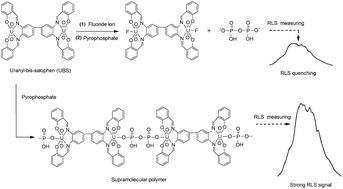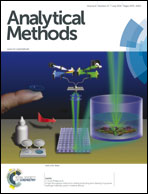Resonance light scattering for detecting fluoride ions based on the formation of a uranyl coordination supramolecular polymer
Abstract
A resonance light scattering (RLS) method for the detection of fluoride ions in aqueous solution is reported in this paper. Uranyl-bis-salophen (UBS), a binuclear uranyl complex prepared by the reaction of uranyl with a ditopic tetradentate Schiff base ligand bis-salophen, was used for the experiment. It is found that after UBS self-assembled with pyrophosphate to form a uranyl coordination supramolecular polymer (SP), the system produced a strong RLS signal. When fluoride ions coexisted with UBS, the formation of SP was inhibited due to which the fluoride ions occupied the coordination sites in UBS. This resulted in RLS quenching. Based on these findings, we established a RLS method for the detection of fluoride ions in aqueous solution. Under optimal conditions, the linear range was found to be 0.005 to 1.5 nmol mL−1 with a detection limit of 0.0028 nmol mL−1. The method was applied to determine fluoride ions in environmental water samples with relative standard deviations of 1.3 to 3.1% and recoveries of 98.7–101.3%.


 Please wait while we load your content...
Please wait while we load your content...